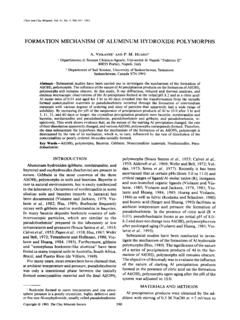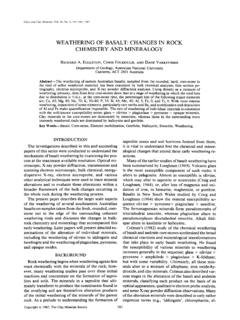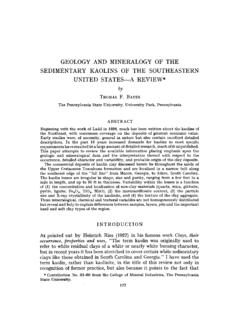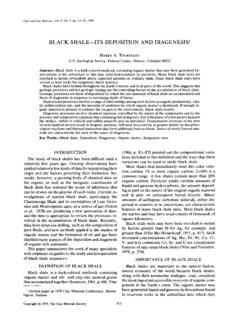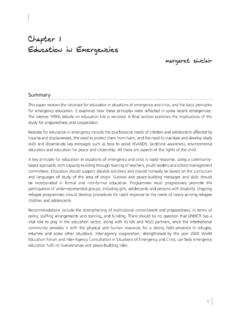Transcription of THE RELATION BETWEEN COMPOSITION AND SWELLING …
1 THE RELATION BETWEEN COMPOSITION AND. SWELLING IN CLAYS*. margaret D. FOSTER. Geological Survey ABSTRACT. The' phenomenon of SWELLING is associated with the hydration of clay; however, all clays do not swell when hydrated. Steps in the mechanism of hydration and SWELLING of different types of clays as observed and intei'preted by several investigators and some theories proposed as to the cause of hydration and SWELLING are reviewed. The concept of clays as colloidal electrolytes that dissociate to a greater or less ex- tent when dispersed in water seems to explain most satisfactorily the significant rela- tion BETWEEN the degree of SWELLING on hydration and the COMPOSITION of the 'clay minerals.
2 In the kaolinite group, in which there "are generally no replacements, the small number of exchangeable cations associated with the clay structure are presumed to b e held by broken bonds on the edges of the sheets. Even though kaolinite, as shown by Marshall, is more highly ionized than montmorillonite, this greater ionization, be- cause of the small number o f cations present and their location on the edges of the sheets, cannot pry the units apart or leave the sheets sufficiently charge d to cause the mineral to exhibit the phenomenon of SWELLING . In the montmorillonite structure, on the other hand, isomorphous replacements, most commonly of magnesium and ferrous iron for aluminum in the octahedral layer, and, to a slight degree, replacement of aluminum for silicon in the tetrahedral layer, give the structure a net residual charge of to mi!
3 Liequivalents , which is neutralized by cations held electrostatically and located, for the most part, BETWEEN the sheets. On hydration such a structure tends to ionize, the degree of ionization depending on (a). the nature of the exchangeable cation and (b) the kind and extent of isomorphous replacements. The characteristically great SWELLING of sodium montmorillohite as com- pared with calcium montmorillonite can be correlated with its much greater ionization. The differences in SWELLING of different montmorillonites have been correlated with the nature and extent of octahedral substitution and are attributed to the effect of these replacements on the anionic strength of the structural unit and its consequent degree of ionization as influenced by the changes in polarization throughout the structure caused by these replacements.
4 Hydrous mica, with the same structure as montmorillonite, is characterized by even a greater degree of isomorphous replacements and, consequently, a greater charge. However, a large part of this charge is neutralized by fixed, nonexchangeable and nonionizable potassium, and ionization of the exchangeable cations is unable to over- come the effect of this fixed potassium. It is probable that the greater replacements in the hydrous mica structure, as in the montmorillonite structure, have a depressing effect on ionization. The result is that hydrous micas are characterized by a very low degree of SWELLING . INTRODUCTION. The phenomenon of SWELLING is associated with the hydration of clays.
5 However, all clays do not swell when hydrated. Those of the kaolinite group, * Publication authorized by the Director, Geological Survey. 205. 206 THE RELATION BETWEEN COMPOSITION AND SWELLING IN CLAYS. for example, exhibit little or no SWELLING on hydration. Sodium montmoril- lonite, on the other hand, characteristically swells in water to many times its dry volume. Calcium and magnesium montmorillonite and the hydrous micas, or so-called illites, fall BETWEEN these two extremes in SWELLING prop- erties, but are, in general, much closer to kaolinite than to sodium mont- moriUonite in their increase in volume on hydration. These differences in the SWELLING characteristics of different clays may be related to their chemi- cal COMPOSITION , to the kind and degree of isomorphous replacements in their structure, and to the amount and nature of their associated exchange- able cations.
6 THEORIES AS T O T H E C A U S E O F H Y D R A T I O N AND. SWELLING . Wiegner (1931) and others considered that the adsorbed cations are hy- drated and that a union of the solvation hulls forms the water envelope around the clay-mineral particles; also the thickness and other characteris- tics of the water film are a direct consequence of the hydration of the adsorbed cations present. According to this concept the greater SWELLING of sodium montmorillonite as compared with calcium montmorillonite is due to the greater hydration of the sodium ion. However, there was consider- able divergence in the values given by different investigators for the size of the hydrated cations and for the hydration in molecules of water per i o n - the measurements did not even provide strong evidence that the cations are actually hydrated.
7 Indeed, Bernal and Fowler (1933) presented data in 1933 that threw doubt on the hydration of some cations. Hendricks, Nelson, and Alexander (1940) later showed strong evidence that (a) the sodium ion, assumed to be most highly hydrated, is not hydrated at all and (b) magnesium and the alkaline earth cations have 6 molecules of water of hydration. Houwink (1937) considered that the thickness of the water film (10 "~to 108 A) was too great to be accounted for by hydration of ad- sorbed cations. Spiel (1940) concluded that solvation of the adsorbed cations could not fully explain the presence of water films. Grim (1942). also concluded that the concept of cation hydration being responsible for the thickness and other characteristics of the water film was not justified and that some other cause for the development of the water film must be sought.
8 As data from investigations of the RELATION of exchangeable bases to plastic properties indicate that the character of the adsorbed cation does in some Way affect the thickness of the water Grim (1942) concluded that it seems "likely that the effect is produced by a binding action of the' cations. That is to say, the cations act as bridges to bind the clay-mineral sheets together. The action is analogous to the effect of potassium in holding together the unit cells of muscovite in the direction of the c-axis. This idea does not preclude a 1V[ARGARET D. FOSTER 207. slight hydration of certain ions, but it postulates the adsorbed cations as con- trolling the thickness of the film water primarily by means of the force with which they hold the sheets together.]
9 ". G r i m continues, "In applying this idea to montmorillonite it follows that the thickness, of the water film is the result of two opposing forces; (a) the tendency of layers of water to develop on the basal planes .. ; and (b) the tendency of the adsorbed cation to hold the sheets together. The resulting thickness of the film is chiefly dependent on the cation.". "It is a well-known fact that Na-montmorillonite expands greatly in the presence of abundant water, whereas under similar conditions Ca-montmo- rillonite expands very little. According to this concept, the great SWELLING of Na-montmorillonite is due not to the hydration of the Na + serving as a wedge to force the layers apart but to the absence of a strong bridge because of the univalent character of Na + and perhaps also because of its small size enabling it to fit well in the hole of the silica sheet.
10 The Ca-montmorillonite does not expand greatly because of the hydration of Ca++ but because the divalent ion holds the layers together so that a thick series of water sheets cannot form BETWEEN them.". A c c o r d i n g to t3aver and W i n t e r k o r n (1935) there are a p p a r e n t l y two w a y s in which w a t e r can be associated with colloidal particles, not t a k i n g into consideration mechanically occluded water. W a t e r molecules m a y be oriented at the s u r f a c e as a result of the electrical p r o p e r t i e s of both the liquid and the surface. W a t e r m a y also be a d s o r b e d because of osmotic effects. T h e first process is associated with the release of an appreciable a m o u n t of heat and is t e r m e d by them simply " h y d r a t i o n.

